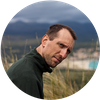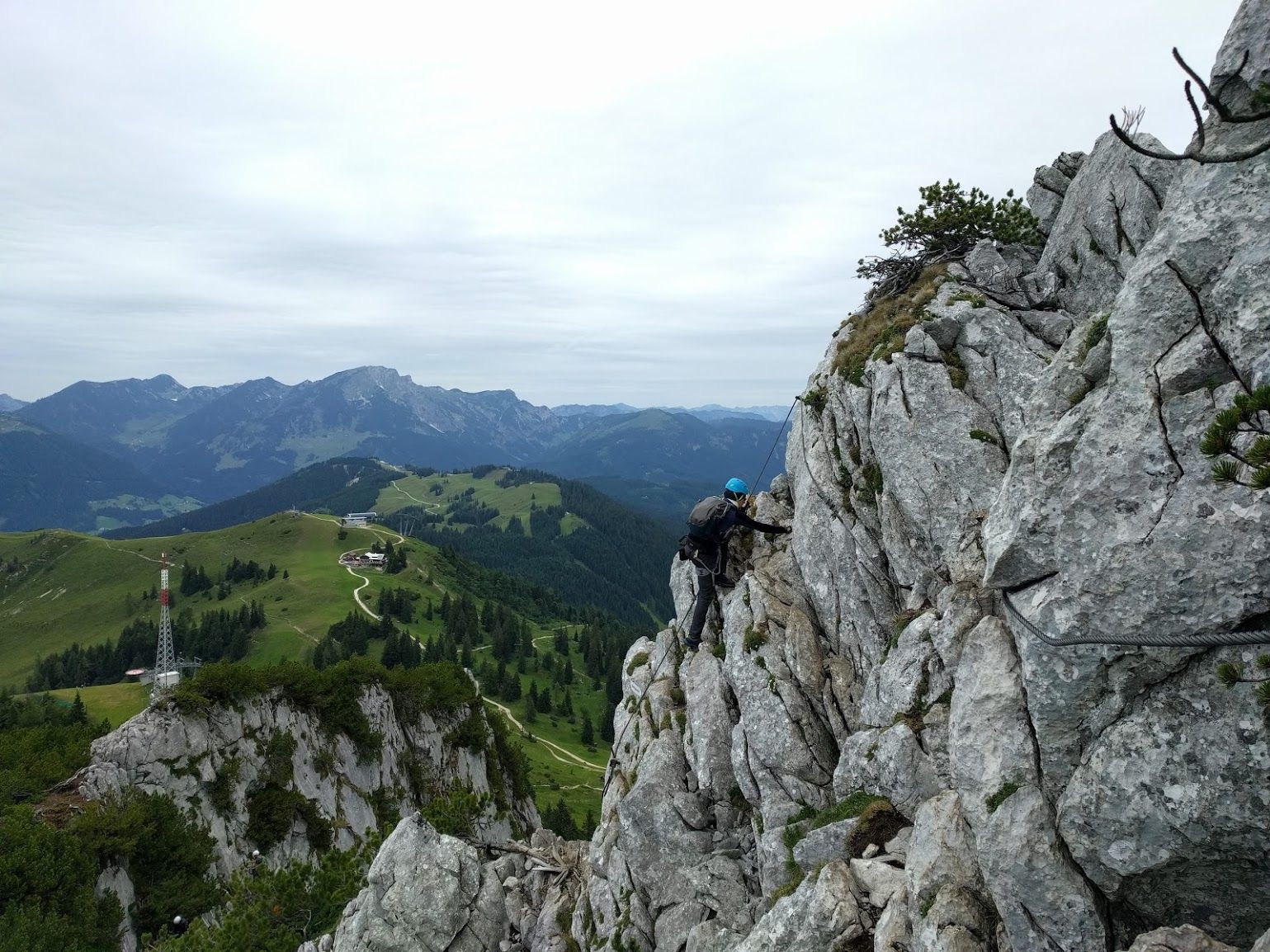Dachstein-Range, Austria, July 10th-13th 2019
Early in 2019 your regular Grime-Buster Bengt asked me over a bouldering session at my gym here in Hamburg, Germany, whether I’d be interested in joining him on a hiking trip in Austria ahead of his mid-summer rope-climbing course (see his account of his Watzman-Traverse). Even though I eventually said yes, I have to admit that I was kinda nervous with regard to keeping up with Bengt, having my huffing and puffing in mind I experienced on our Massanella-Trip some months earlier when trudging up the mountain behind him. This time was going to be different, though: Having taken to climbing recently, Bengt proposed a 4-5 days trip combing hiking and climbing on something called Via Ferrata (Italian: Iron „Rail“way): relatively short hikes on mountainsides and ridges that are secured by fixed iron ropes that you latch on to for protection and thus can enjoy breathtaking views from locations otherwise inaccessible to anyone lacking proper climbing skills. A casual regular at my climbing gym for about one-and-a-half years then, that seemed to be a great opportunity to finally get my butt into the great wide open, climb a lot over a prolonged period of time and generally have a blast with Bengt.
I left the planning mostly to the experienced adventurer and a few months and an 8 hour train ride later picked him up at Salzburg Airport to get into the thick of things on the slopes of the Dachstein mountain range in western Austria.
Day 1
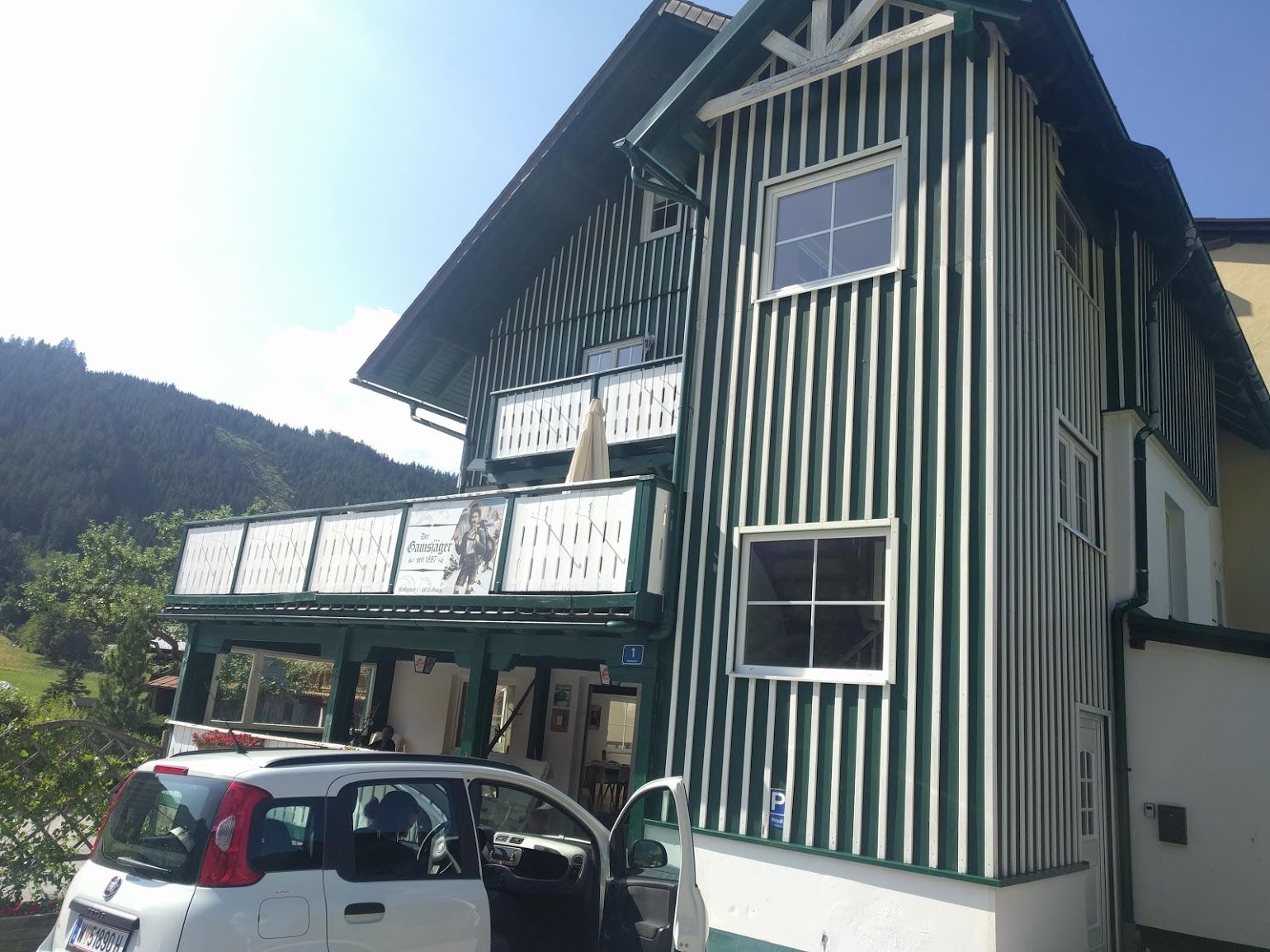
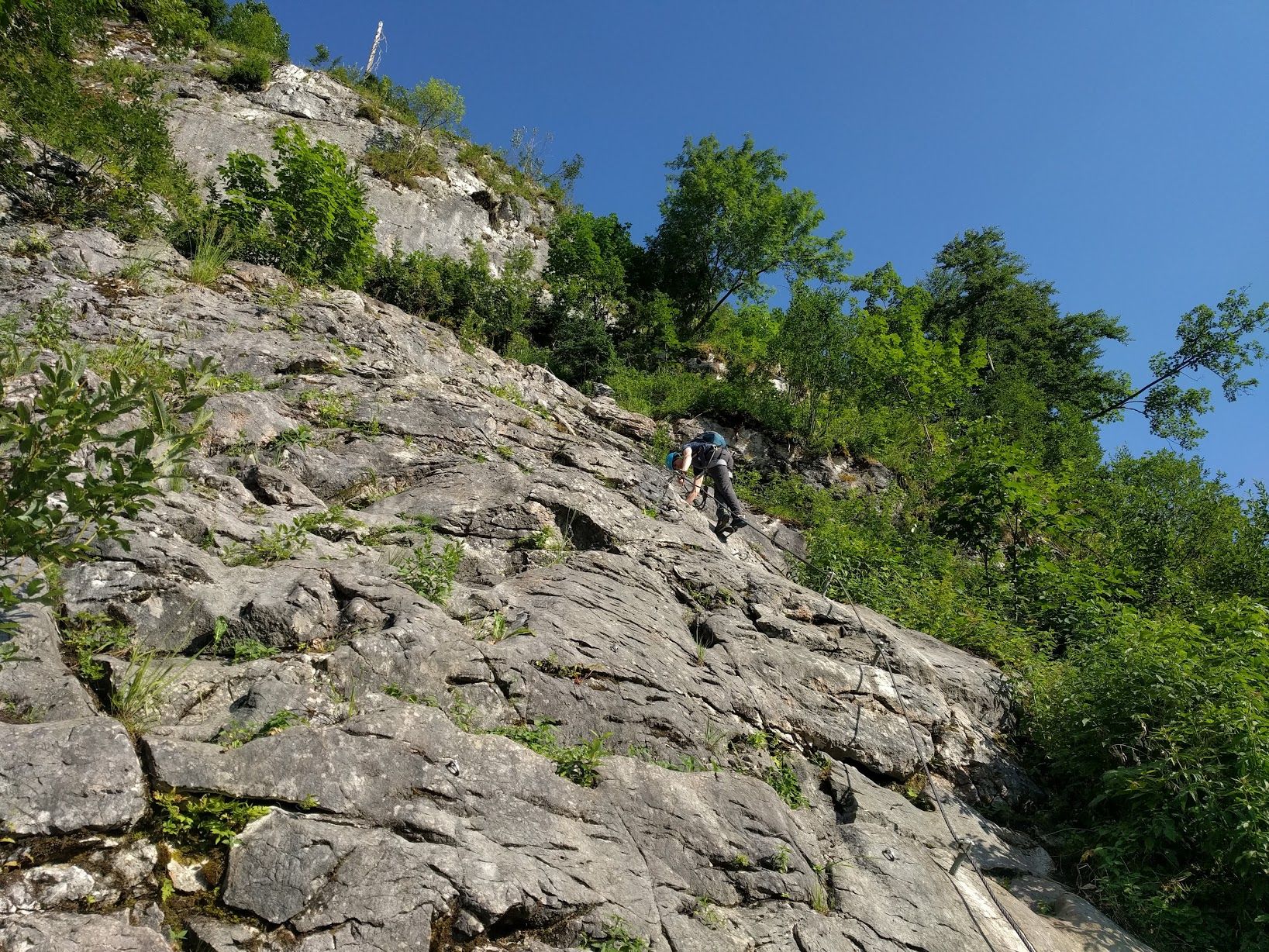
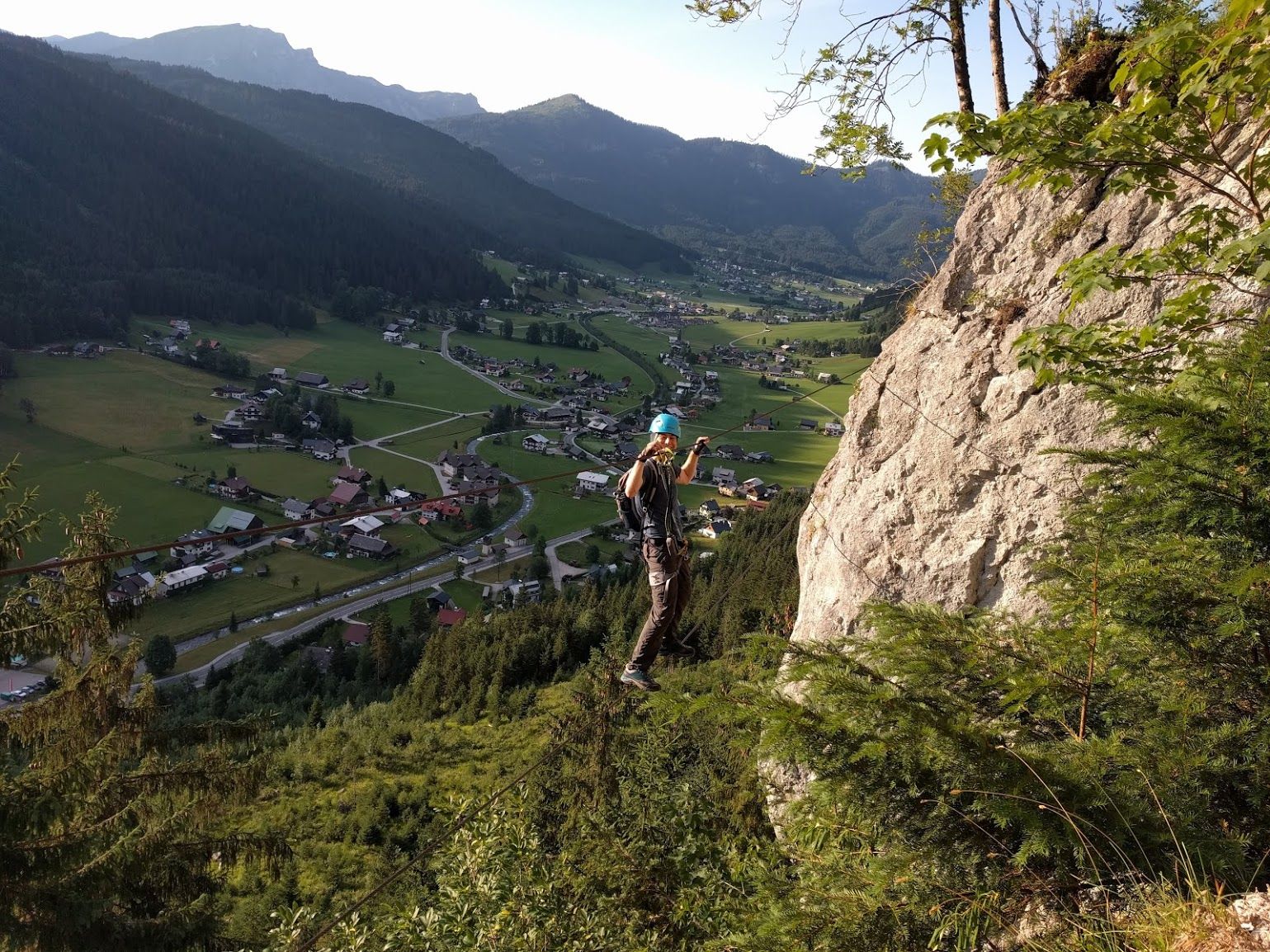
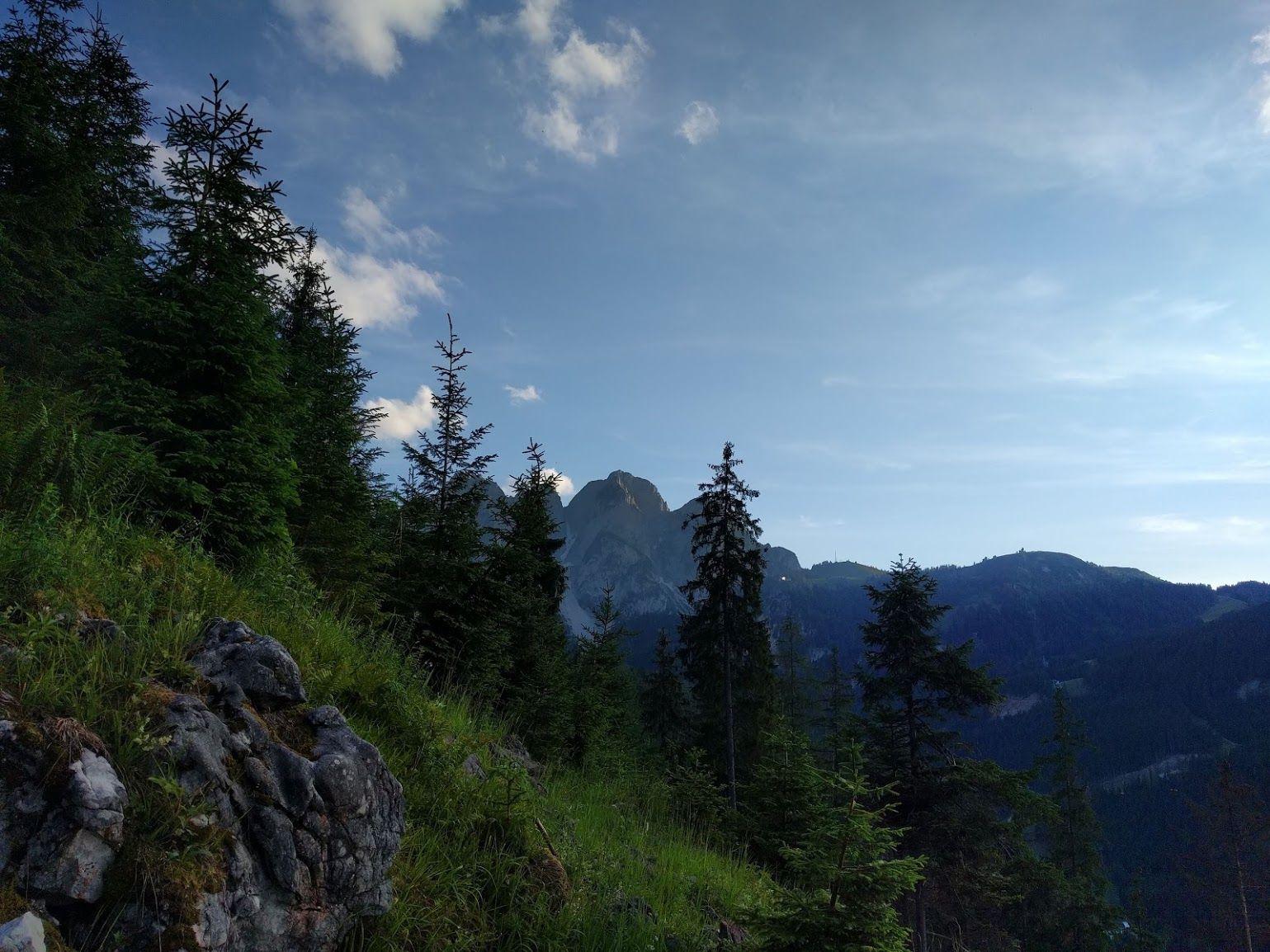
Our first destination was to be a little valley around the charming city of Gosau, some 70 kilometers from Salzburg on the northwestern ends of the Dachstein. Having checked in at a little hotel at the very edge of town, we immediately set out for a taste of Via Ferrata-fun at the „Schmiedsteig“ Klettersteig (German: climbing path) just a 15 minute walk away: This set of about nine different Via Ferrata routes bolted into a wooded cliffside overlooks a little lake and even provides a distinct training route called „Brunbachsteig“, ideally suited for our purposes. Having only bought my equipment the other day (don’t I sound prepared?), Bengt pointed me to the right set up of my climbing harness and off he went, me following suit. Most prominent observation in this stage: climbing a Via Ferrata might include climbing downwards which – in the words of Kevin Jorgeson – „feels like running backwards“ (Jorgenson in „The Dawn Wall“, 2017). Weird, but definitely fun AND a heck of a lot easier than expected!
That said, being summertime, having still a lot of sunlight left and totally pumped up, we decided to go for „the real thing“ next – the original Schmiedsteig itself, a 600+ m traverse (mostly sideways going route) of this picturesque cliffside that, as it turned out, is only marginally more difficult than our training route. The length of this route packed a sample of almost all support elements you are likely to encounter along Via Ferrate (pl.): piton supported ladder-like ascents, actual ladders fixed horizontally to the wall giving you something to put your feet on, even a steel rope-bridge across a small gorge. That last one was a little more shaky than I expected due to a broken off piece of support beam holding the overhead iron rope in place – once on the bridge, the sudden movement there startled me good! Bengt climbed a short way around this little obstacle but neither of us was put off by this tiny hiccup and we never had another one like this: Via Ferrate, especially in Austria and Switzerland, are very well maintained since they primarily target people coming from hiking and with even less climbing experience than Bengt and me. – Lovely views across the tree-tops up above, a good walk down through fresh forest air and a good dinner on lamb roast in a local restaurant concluded this excellent day that had us excited for our big tour the next day: the ascent of the intriguingly named „Donnerkogel“ (trs. to „Thunderpeak“).
Day 2
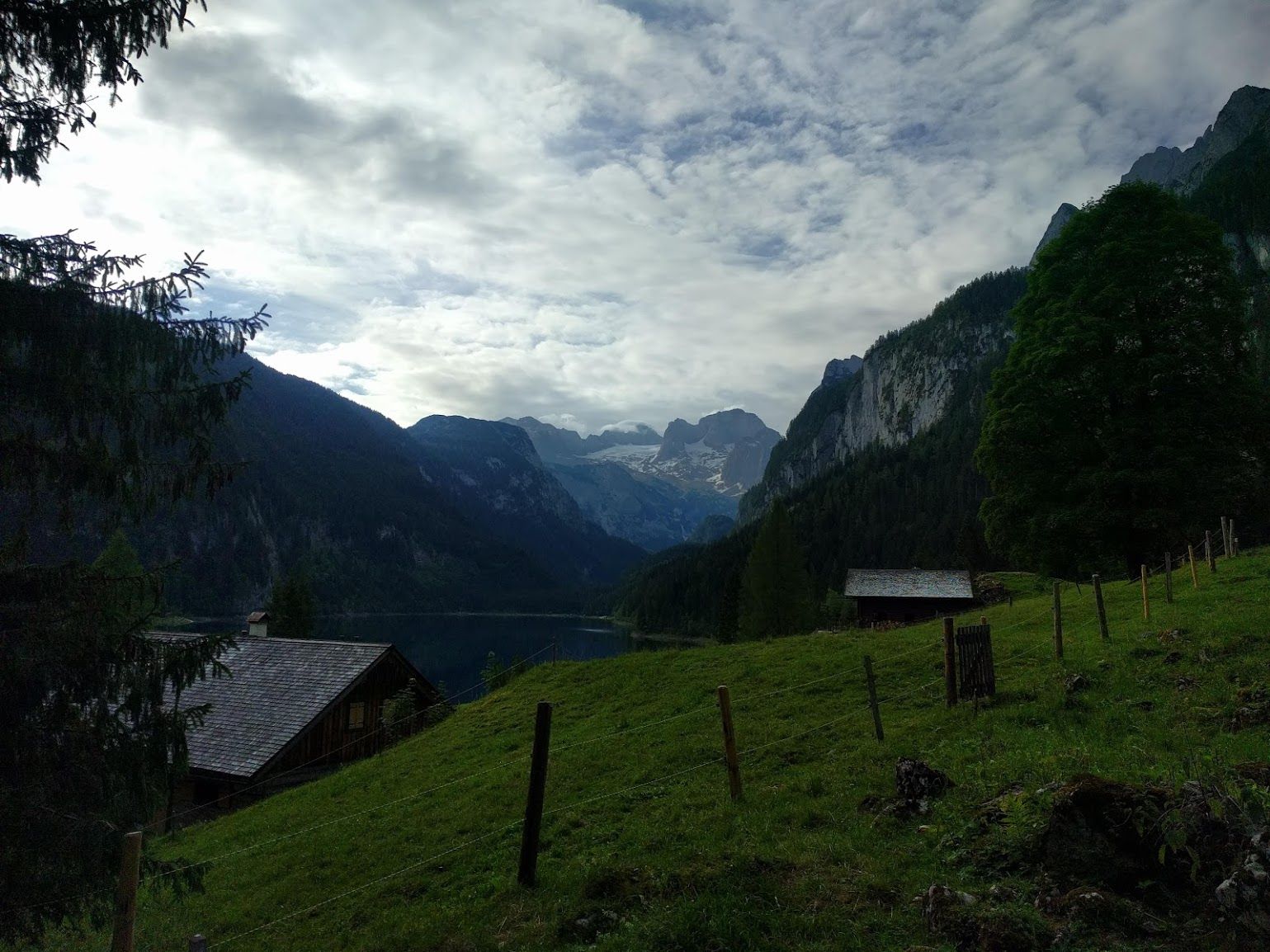
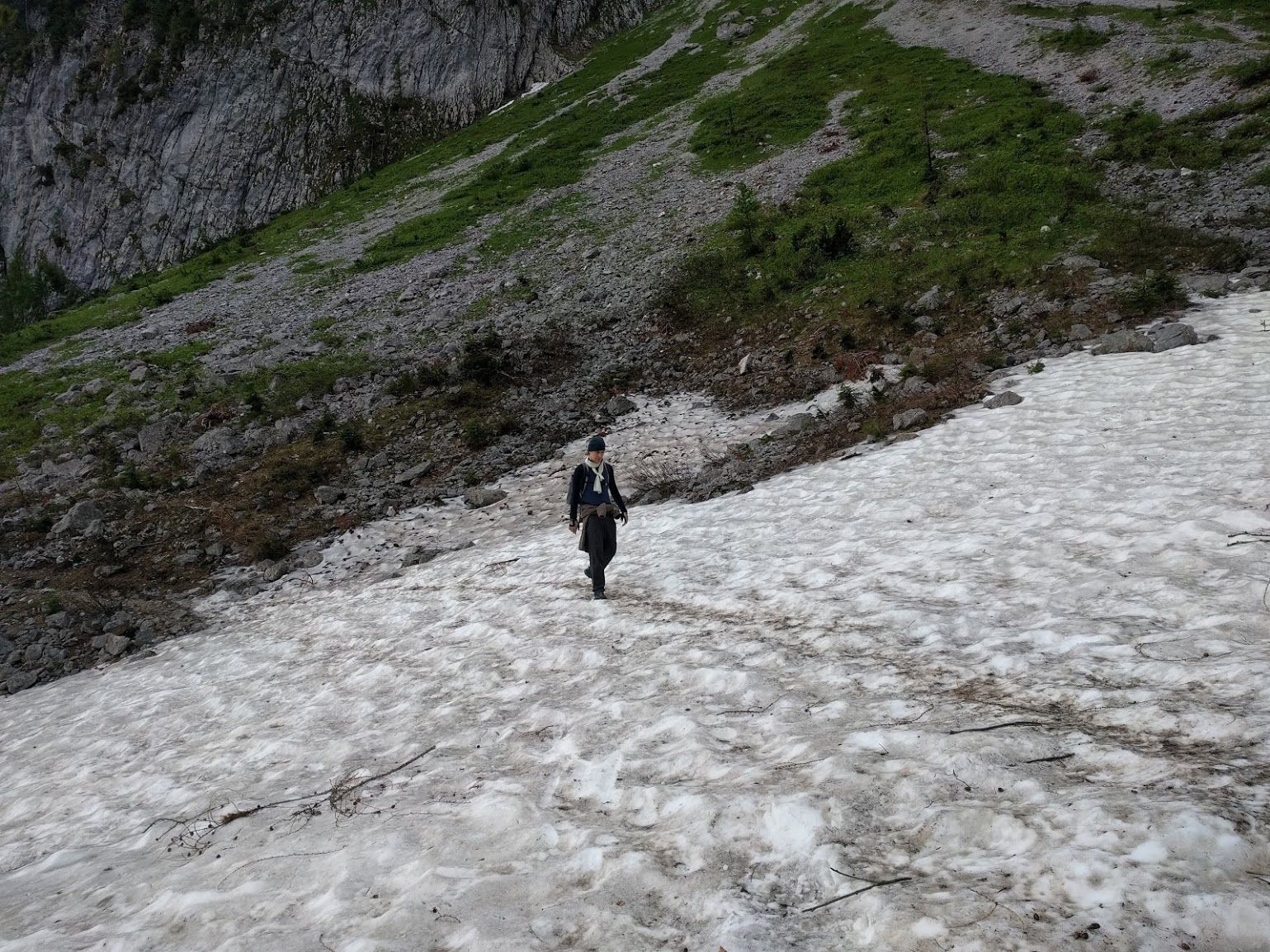
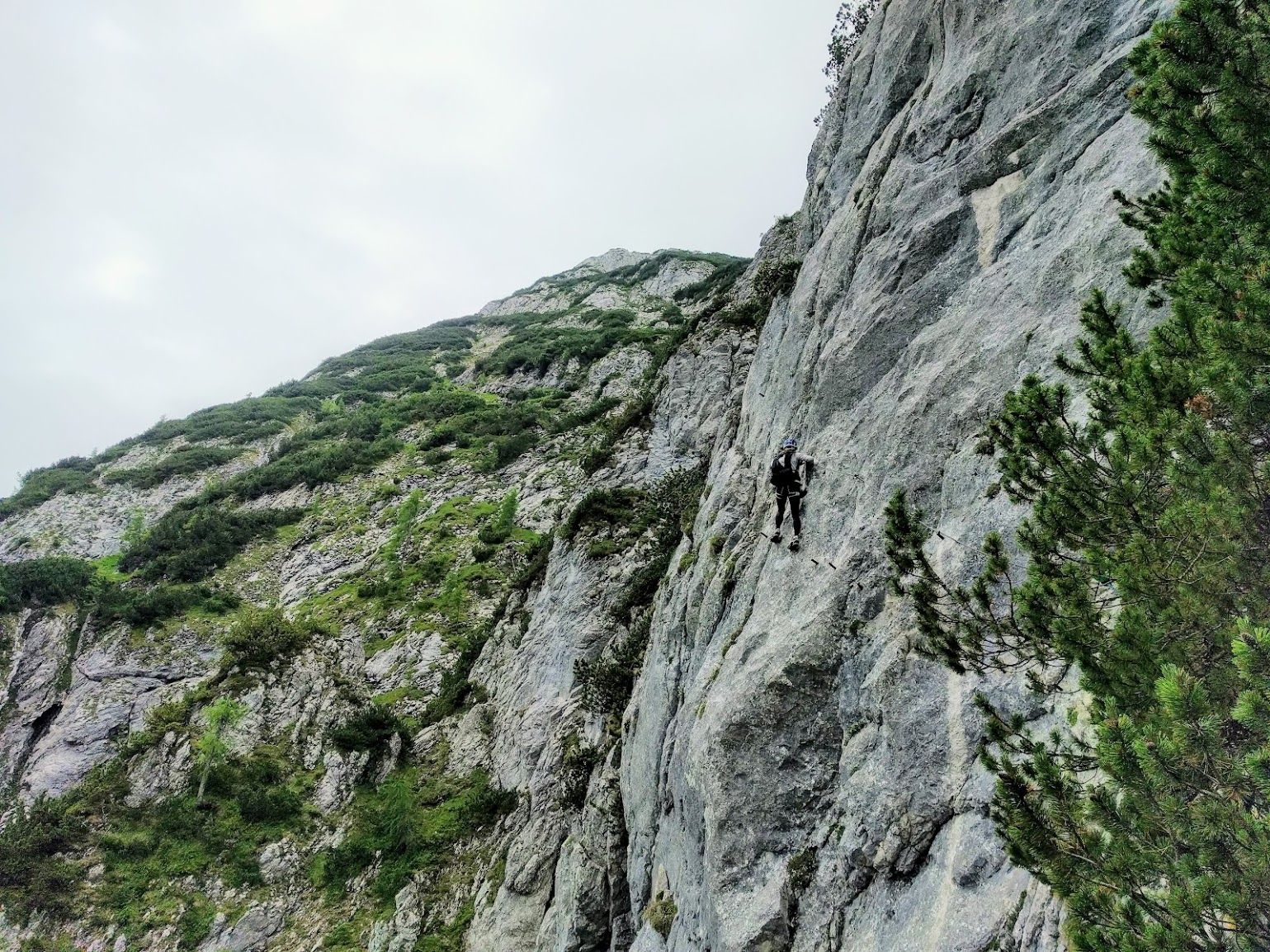
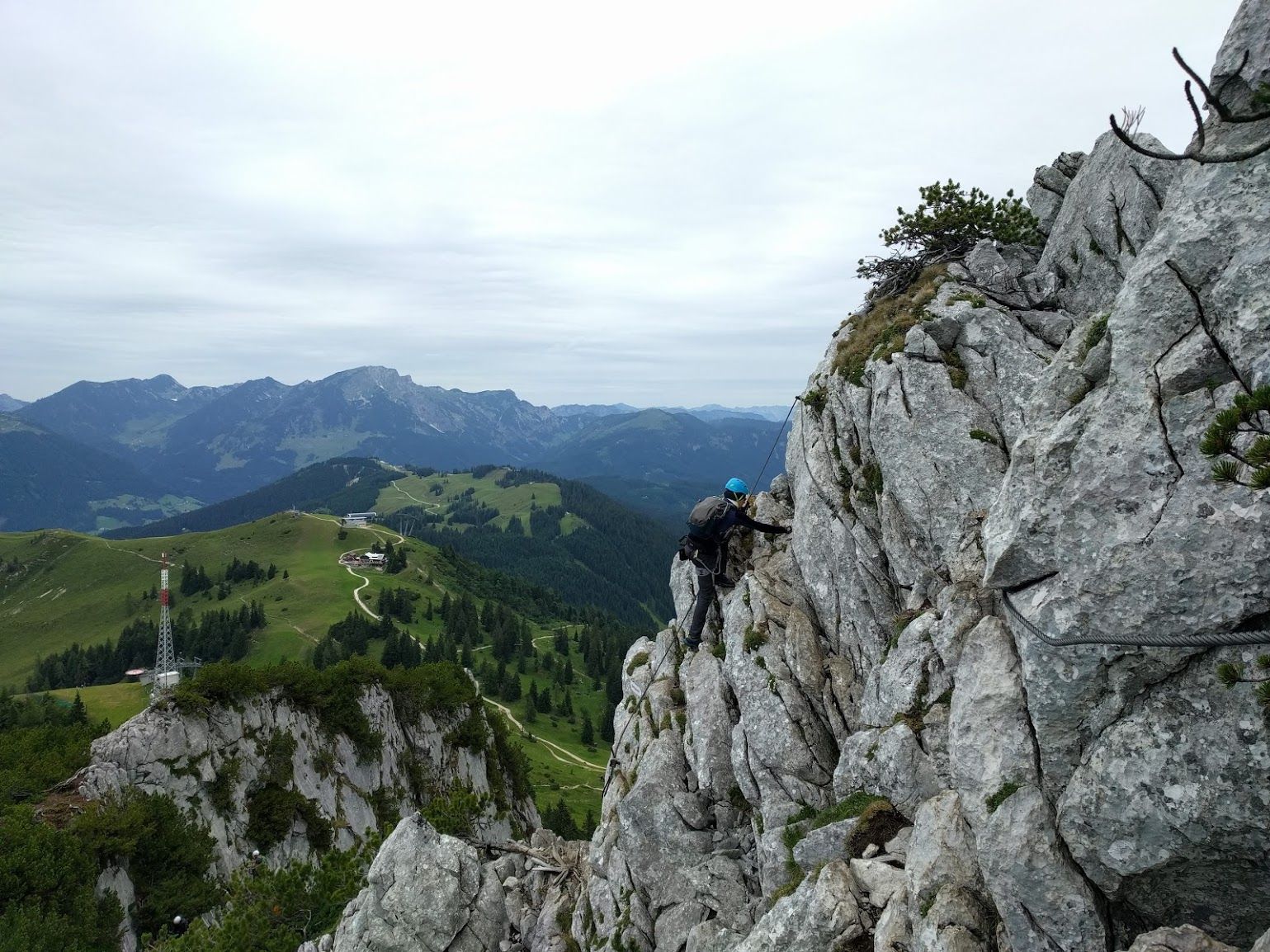
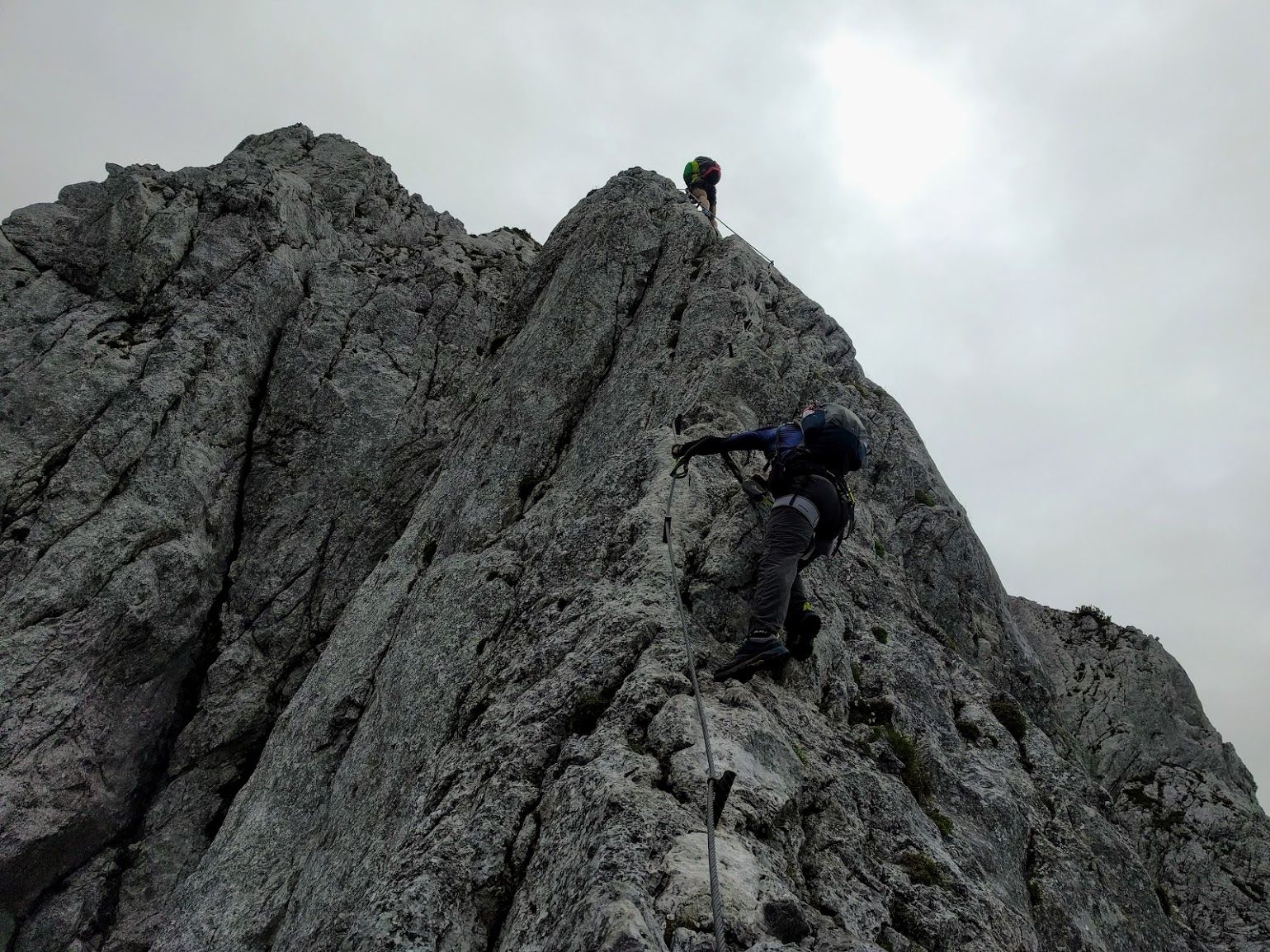
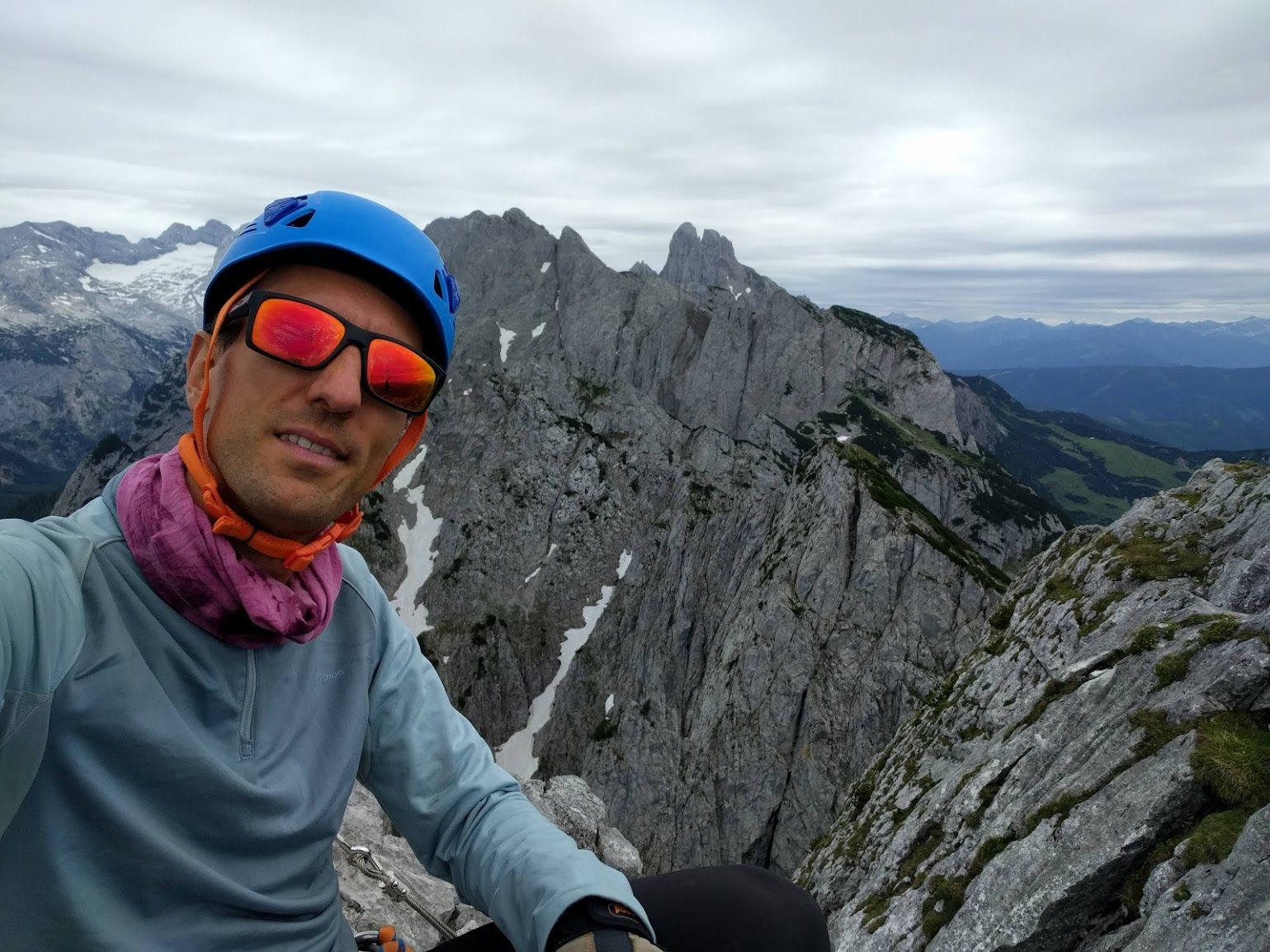
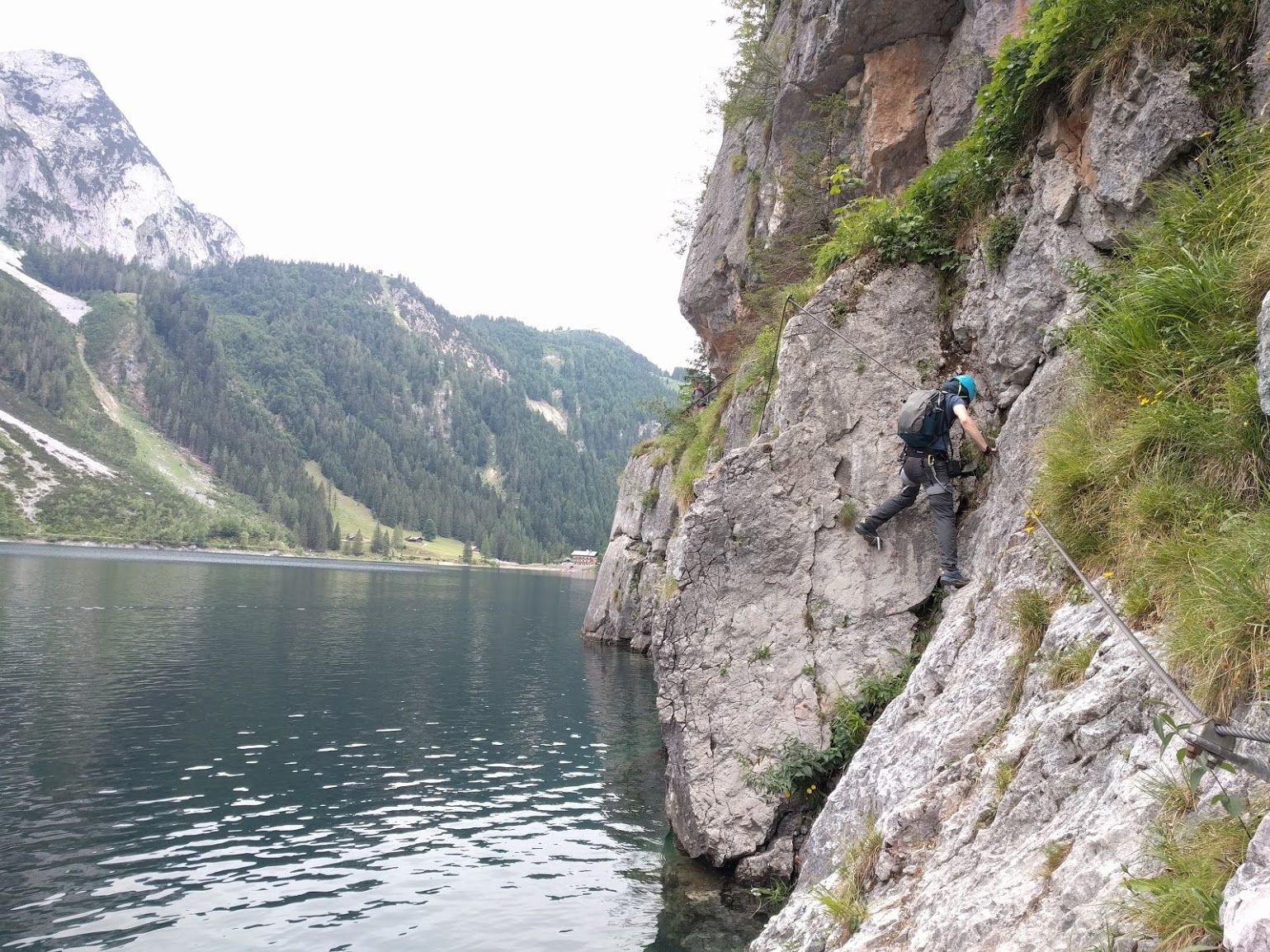
An early start had us meet the day with grey skies and a mild chill in the air. Since we would change locations after our climbing, we packed up our things and left the valley to the south, heading towards the even bigger upper Gosau-lake right at the feet of the Donnerkogel. Across the length of the beautiful, impressive mountain lake we could see the peak of the Dachstein itself, and boy, what a sight it was. – Living in the plains of northern Germany and never really having been up in the mountains before, seeing a glaciered mountain towering over his peers from this close was a real „Naturerlebnis“ for me [„Naturerlebnis“ (ger.) – immediate personal experience of nature].
With this view to the left we made a 40 Minute hike up a steep forest trail, crossing a partially frozen rubble field where we saw a few wild chamois mountain goats clambering amid the rocks. They probably saw us, too, and thought: „Amateurs!“
Eventually we reached a small inn sitting next to a cable car station (that we had ignored on purpose for our way up), took an espresso there and set out for the adventure of the day. Information on the route gives estimates of about three hours pure climbing/scrambling in a variety of terrain that challenges all the muscles in the body as well as requiring an enormous amount of concentration. This last aspect particularly had me give all that I had: it felt as if Bengt dashed off ahead (again) whereas I climbed carefully and slowly, getting overtaken by more experienced climbers more than once. That did sting a bit, I have to admit.
I finally caught up with Bengt at the ridge coming from the small Donnerkogel (a smaller peak right next to and about 140m shy of the Donnerkogel itself) and at the foot of a huge, 40m steel rope „Sky-Bridge“ crossing a chasm next to the ridge probably 90+m deep. Quite an impressive sight! – After a half hour break there, Bengt asked me whether I’d go first climbing the final stretch and whether I wanted to walk up the easier (if scary) sky bridge or climb the second, though optional crux, the steep „Donnermandl“. This slender pillar of rock shoots up from the shoulder of the big Donnerkogel and confronts you with a lot of exposure, aka air under your butt.
Looking back, my bruised pride might have pushed me to claim that I „had come to climb, not walk stairs“ – in any way, I went ahead and pushed through some of the steepest and most fun (!) passages of the whole trip. This finale has probably some of the most „real“ climbing parts, meaning that there is more coordinated movement of all limbs on your body necessary than anywhere else on this route. 2,5 hours into the Via Ferrata, mind you. Being able to do this easily gave my ego a welcome little boost. Practice breeds mastership, right?
Coming down from the summit and returning back to the lakeside took us a good two hours. That walk puts strain on your knees as we would find out the next day, yet then and there we once again had a good long afternoon left to fill. „We came to climb“, and so we did! A look into Bengts list of optional nice-to-have routes we decided to go for a 45 Minute round trip Via Ferrata on sheer cliff sides right next to the lake (called „Laserer Alpin Klettersteig“). That one starts from below a scenic lakeside walkway, just 1,5m above the waters, traversing some 80m or so before going straight up and back in the opposite direction, only this time above the walkway. You’ll get an audience there just doing this, either from people cheering from their little boats on the lake or people telling their wide-eyed children, those people up above on the rope-bridge are a little insane. Comes with the job, I’d say, but fun nonetheless. Also, here we got to practice some down-climbing. Still weird.
Having done 3 hrs of hiking and 4+ hours of climbing, we called it a day and drove about an hour to our next destination and headquarters for the coming days, Ramsau am Dachstein. Primarily known as a winter sports resort, summertime has a lot of the hotels and restaurants there either closed or offer very affordable rates as well as some nice goodies such as a „Summer card“ for guests that, unexpectedly, came in quite handy. Being at a wintersport resort and late to eat out that night, we ended up having dinner in a small „aprés ski“ party pub that offered very good local beer as well as less impressive, but nourishing food at small rates. Also, an interesting sample of locals that spoke the regional dialect which puzzled me at times. More is to be said about these linguistic specialties later on. Our bed & breakfast offered simple, clean rooms and a nice spread to feast upon in the morning. All we needed, all we wanted, excellent.
Day 3
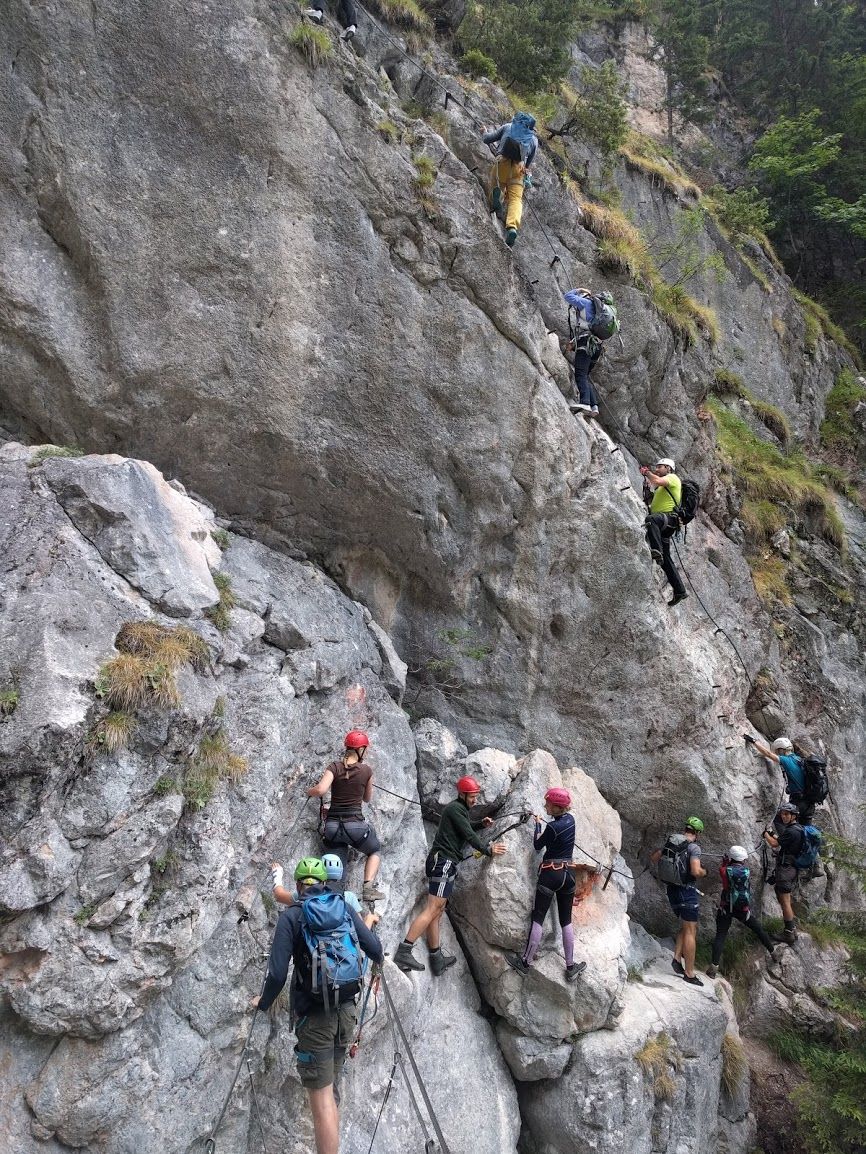
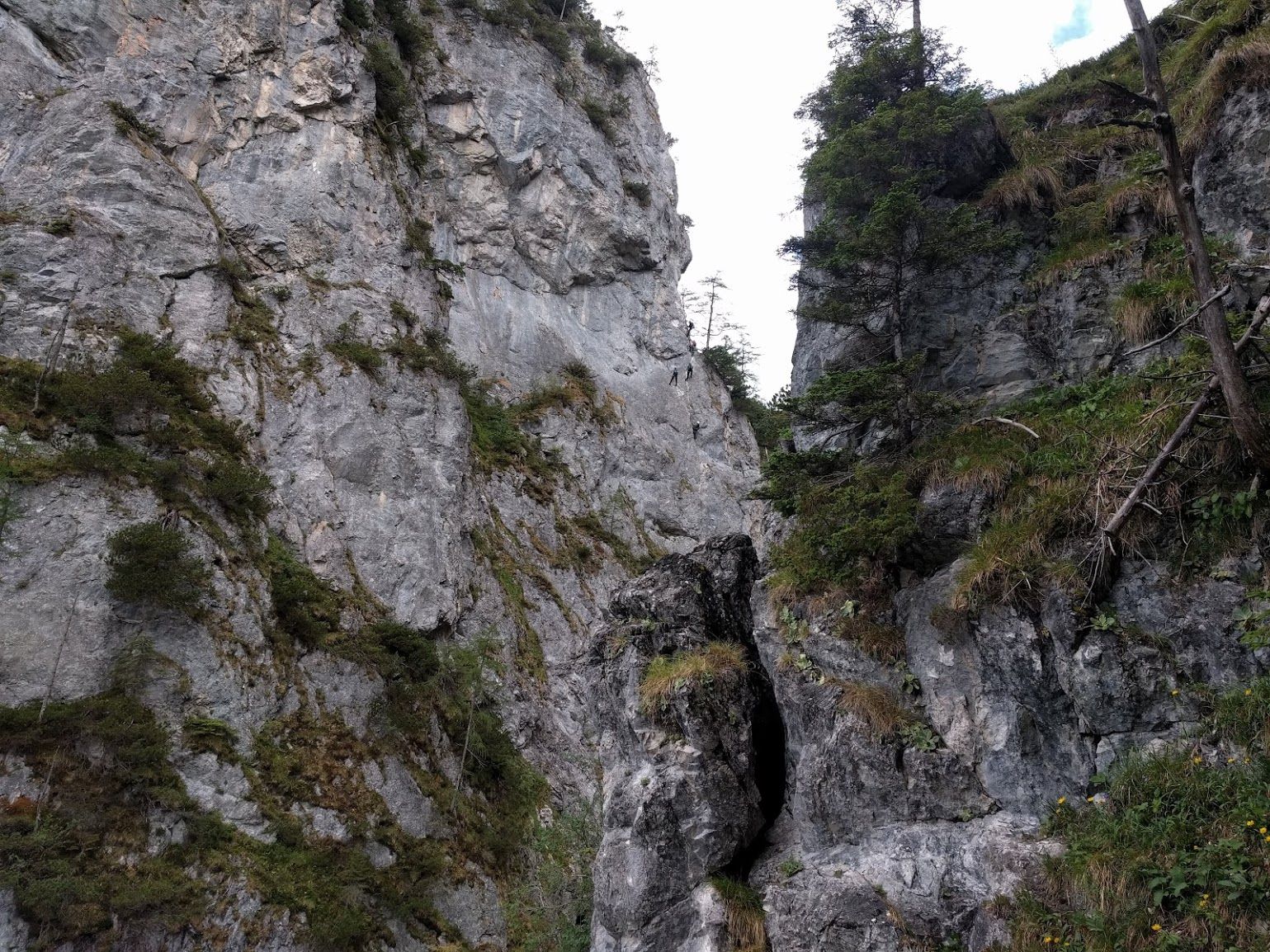
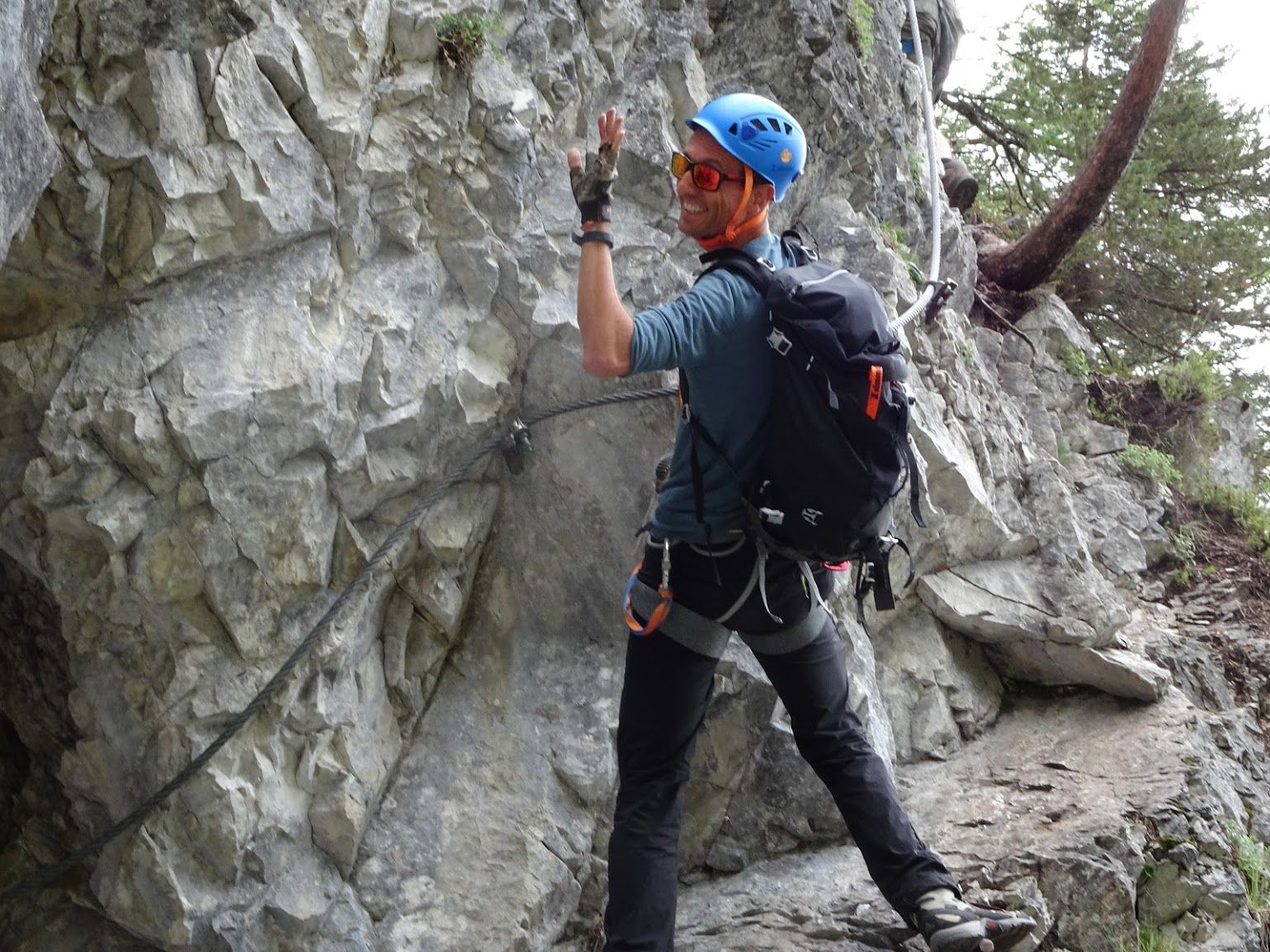
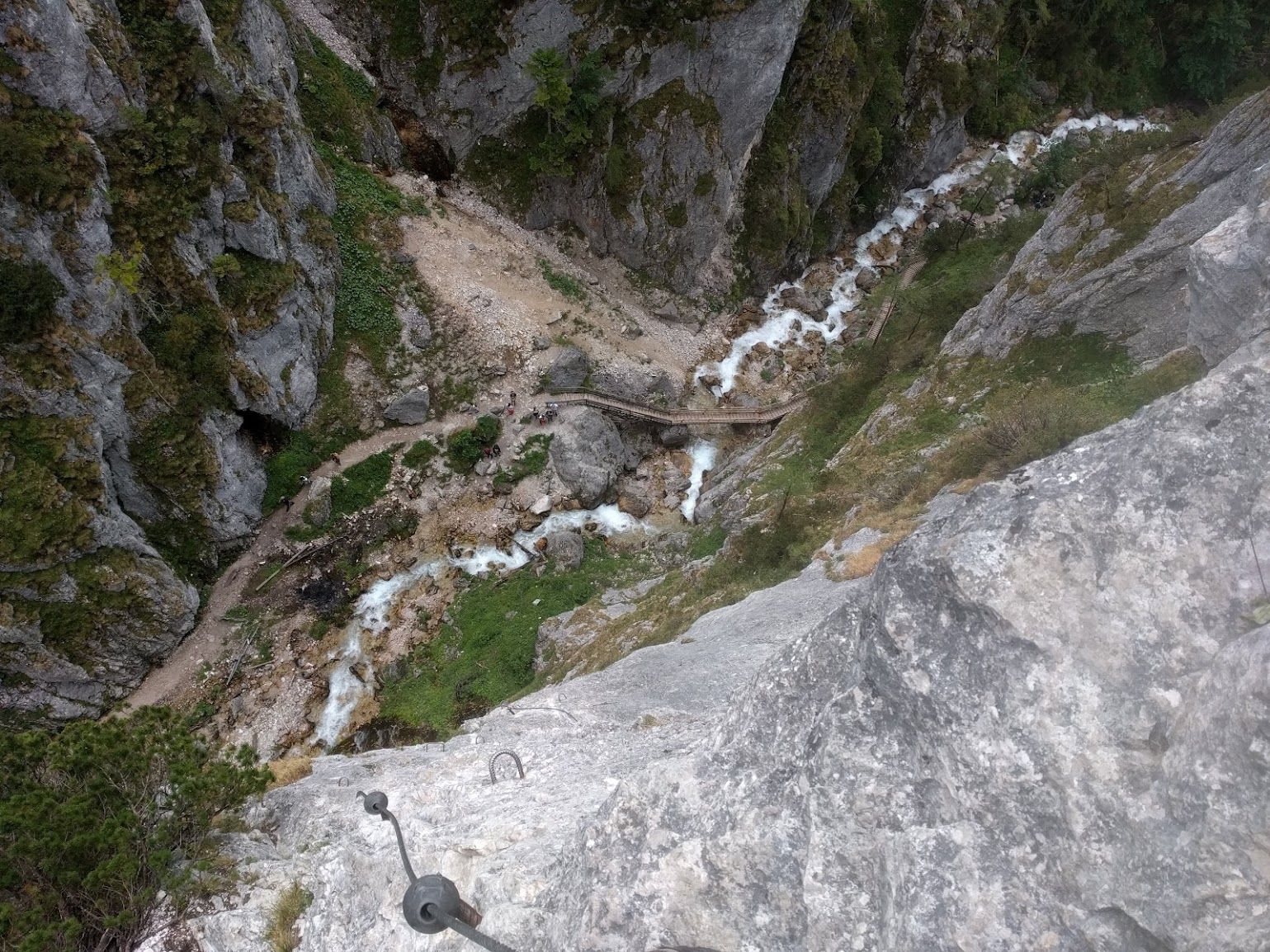
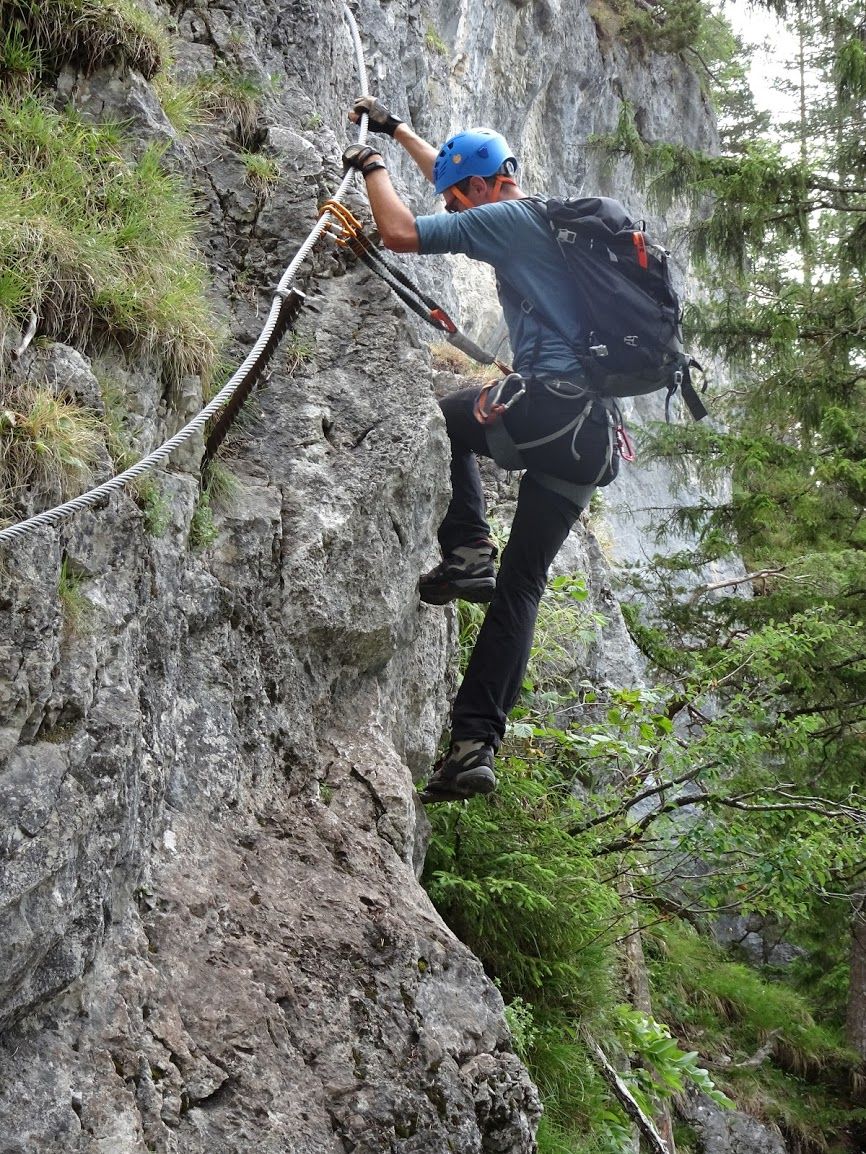
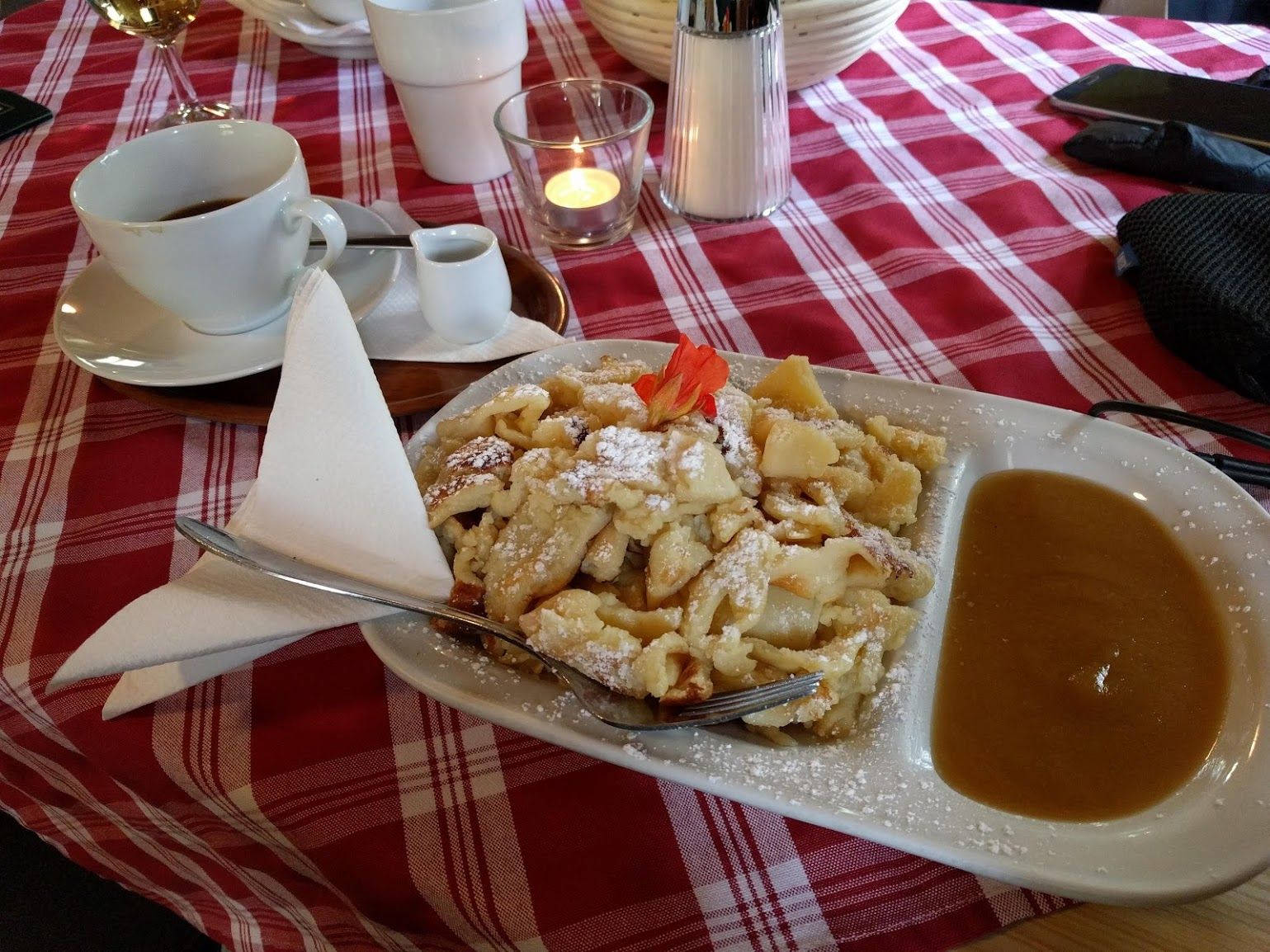
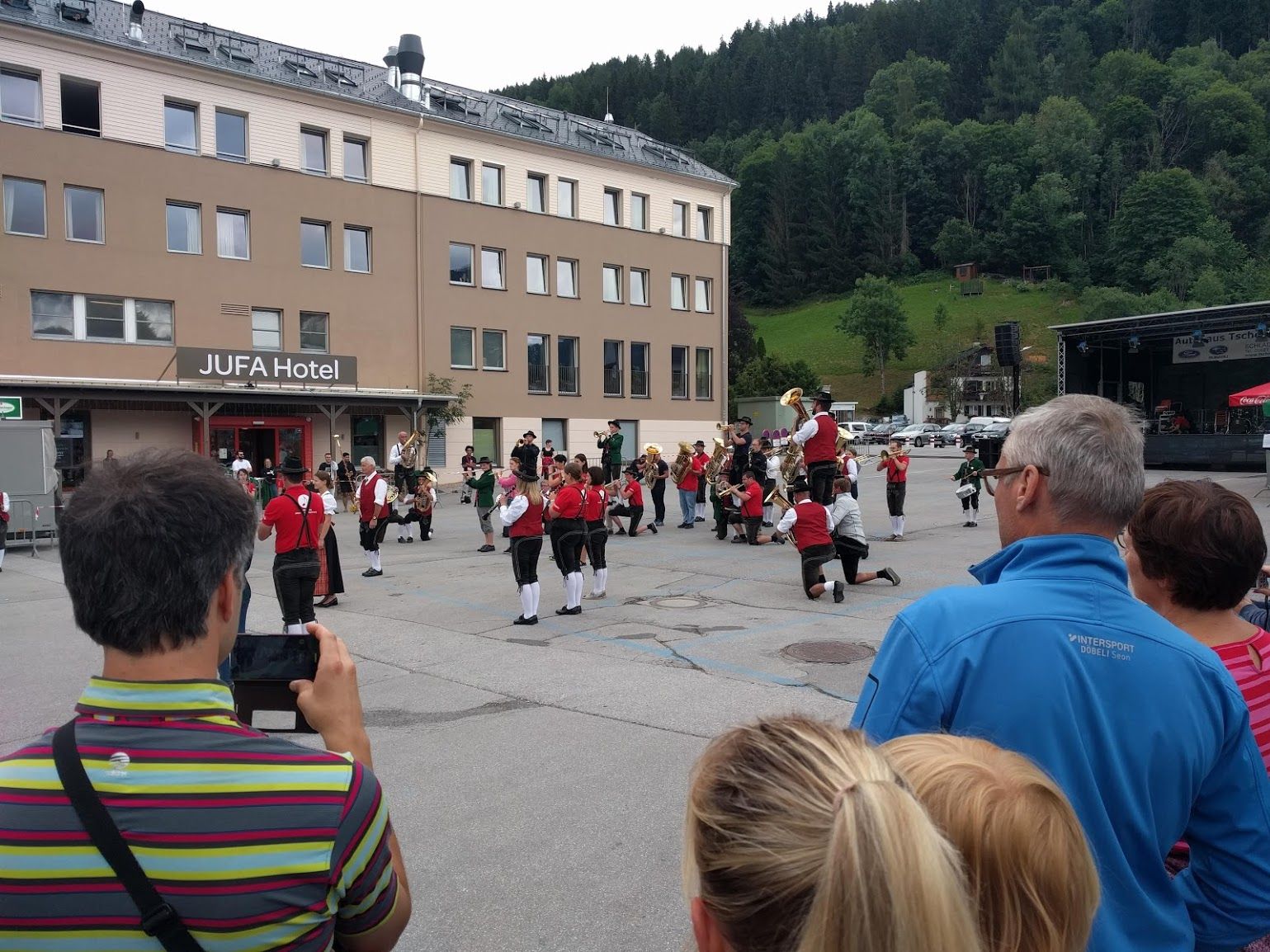
By our third day the weather started to change perceptibly. Whereas the previous afternoon we had changed into short-sleeved shirts when climbing by the lake, those were out of the question now. Forecasts predicted spouts of rain throughout the day and falling temperatures which made us suspect that our intent to traverse atop the Dachstein summit ridge might turn out to be all but unfeasible. As that would take a whole day’s effort, we hoped for better conditions tomorrow and opted for a series of three shorter Via Ferrate spread among the walls of a rather small cirque valley known as „Silberkar“ (ger: Silver cirque) only a stone’s throw away from Ramsau.
The Silberkar lies at the end of a steep road leading to a narrow cleft in the mountainside: this „Silberkarklamm“ (Klamm, ger: gorge) being a popular spot for day trips, the parking lot and slim hike trail ascending into the valley through the gorge was almost crowded. We ended up queueing for 10 to 15 Minutes behind two 10+ climbing groups at the start of our first route of the day, the „Hias-Klettersteig“ right in the middle of the gorge. The route clings to an impressive cliff-side consisting of mostly steep sections and while providing superb hand- and footholds, surely puts your nerves to a test: being in the flow ourselves by then, we overtook most of the climbers who had gone ahead and generally breezed through this route never minding the sheers drops right beneath our feet. From the top it took a good half hour walk circling back to the upper end of the gorge, where we started up our second route, the even more demanding Via Ferrata called „Rosina-Klettersteig“. Pumped from our successful previous ascent, this imposing part of the gorge’s sidewall and info that this route entails persistent effort throughout, making it the Silberkar’s hardest climb, the Rosina was the challenge we were looking for that day. – One of the most demanding overhang sections of our whole trip high up on the route and long stretches with bad holds had us repeatedly rely on the fixed steel rope to get up. Having put such a strain on hands and forearms there, at the end of the route I seriously wondered whether I’d be up to another one today. It’s worth mentioning,again, then: good to have a machine like Bengt at my side to pick me up and drive us on!
Yet, the two routes below our belts had taken their toll: our pace had slowed noticeably and when we reached a crossroads on our descent leading either down to the Silberkar’s mountain lodge or up the back of the cirque and its third Via Ferrata, the „Siega-Klettersteig“, it was Bengt who urged us on and up to at least have a look. We could always turn back, right? – Not as easy to do than say, as the ascent proved to be littered with large sloped scree fields that easily started slipping stepping up and even more so going down. So doubts and exhaustion cast aside, we plodded upwards until we reached a protruding crag that marked the start of the Siega-Klettersteig, where we were in for a bit of a surprise:
While recuperating there for half an hour, we were joined by a family of three including a whee boy of eight to ten years of age. They immediately started up the route and it was clear they had done this before, going up roped together, mom ahead with the son tied in, the dad supervising the little guy from behind. Watching them, it became quickly apparent that we’d have to overtake them somewhere en route if we didn’t want to risk the weather to turn while being still in the open. Bengt going first, he was able to pass them at a good place early in the route. I, however, only caught up with them in a series of sections where passing was all but impossible. So I got to listen to the little guy bleatingly and precociously gripe to his dad about every little detail of the rock for 20 minutes or so, all the while clinging strenuously to the wall.
Finally, they politely invited me to use an opportunity to pass them: but just as I straddled around the little one with a LOT of air under under my butt (a more desperate move than I anticipated), the little wise-ass started bleat again. It that moment, I couldn’t help but rebuke him with a stiff „Shut up for one minute, I gotta concentrate!“. Not quite the polite climber’s conduct, but: sorry for not being sorry.
It took me a good 45 Minutes to catch up with Bengt. We only met up 15 minutes after he had reached the top of the route and taken a lot of pictures of the stunningly beautiful valley to his feet. We then started our descent towards the mountain lodge, reached it just 5 minutes shy of a sudden and pounding downpour and got to quench our thirst and calm our rumbling bellies on some good soup and sweets. Once the rain had subsided, we hiked back down the lovely mountain pasture to the car and had a relaxing and entertaining afternoon in the next bigger town, Schladming. One curious highlight worth mentioning: we stumbled into an International Brass-Band festival, with free concerts all throughout downtown Schladming. Not our usual musical fare, to say the least, but: a military brass band playing the famous „Radetzky March“ in front of town hall against the backdrop of an olympic ski-jumping park while half the audience blazons traditional garments of various national regions? – It don’t get any more Austrian than that!
Last instance of culture shock for the day: the mutual failure of a waitress and me to communicate effectively about the ingredients of traditional dishes on the menu. Bengt, having lived in Bavaria for a time, had a good laugh at us: at the waitress for not realising at all that I didn’t get the meaning of her words and at me for asking dumb tourist questions. Oh well…
Day 4
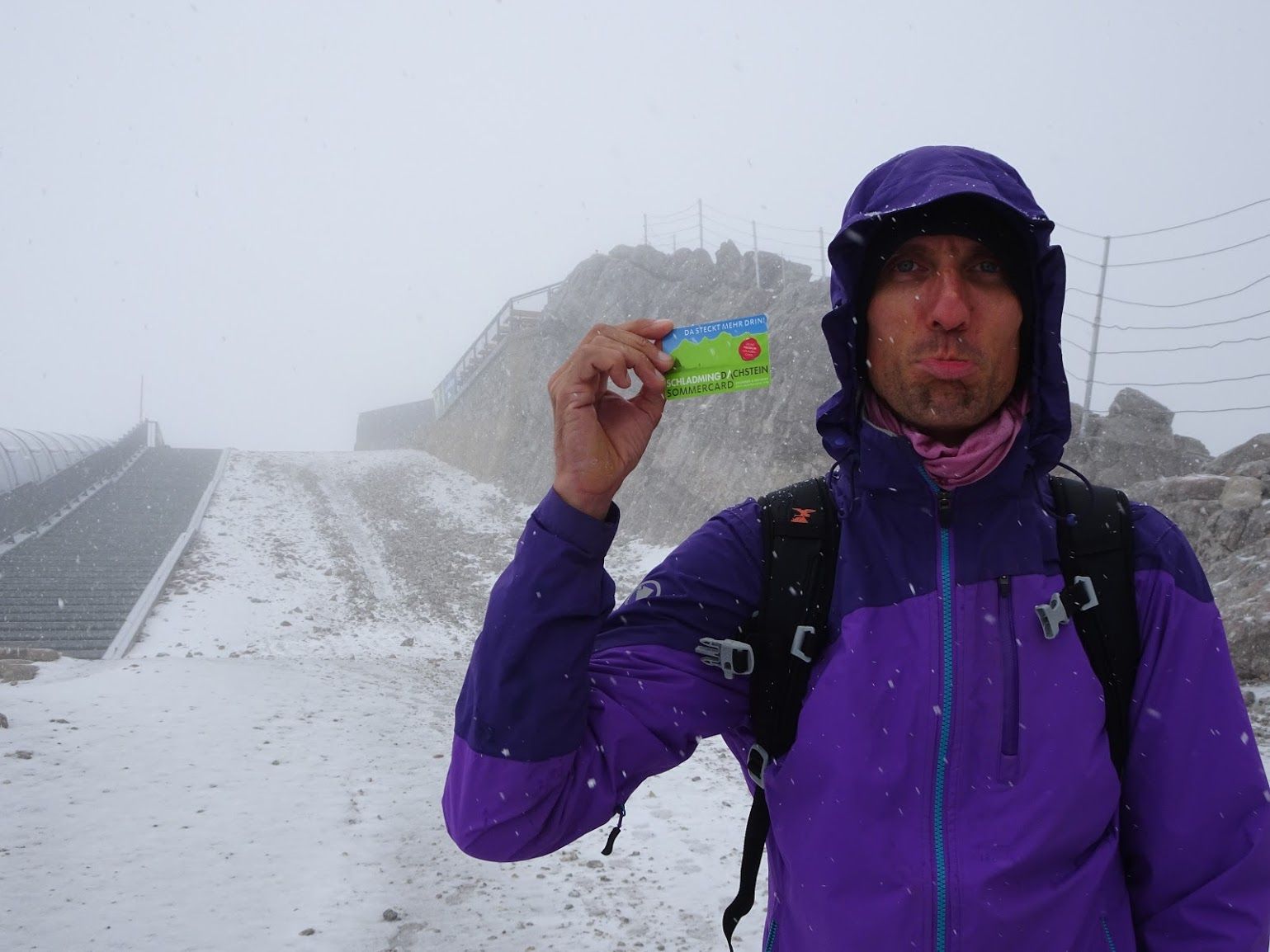
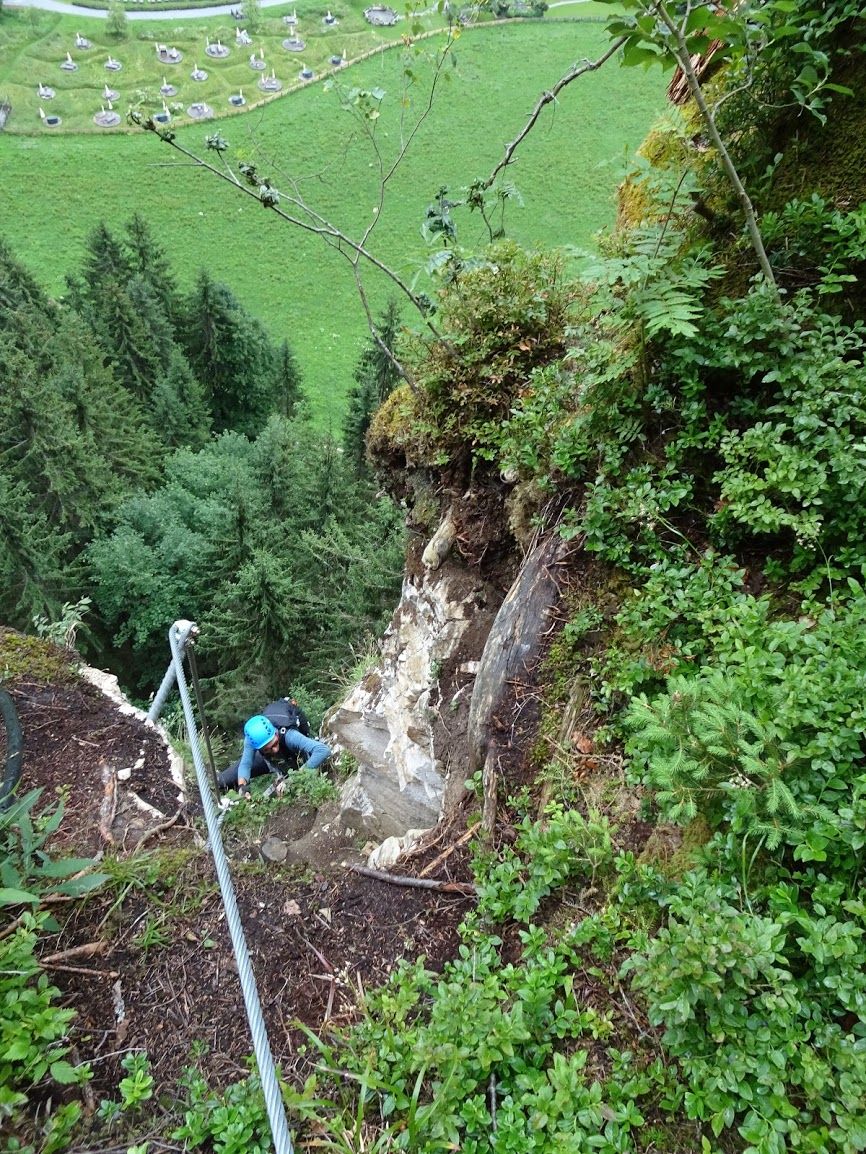
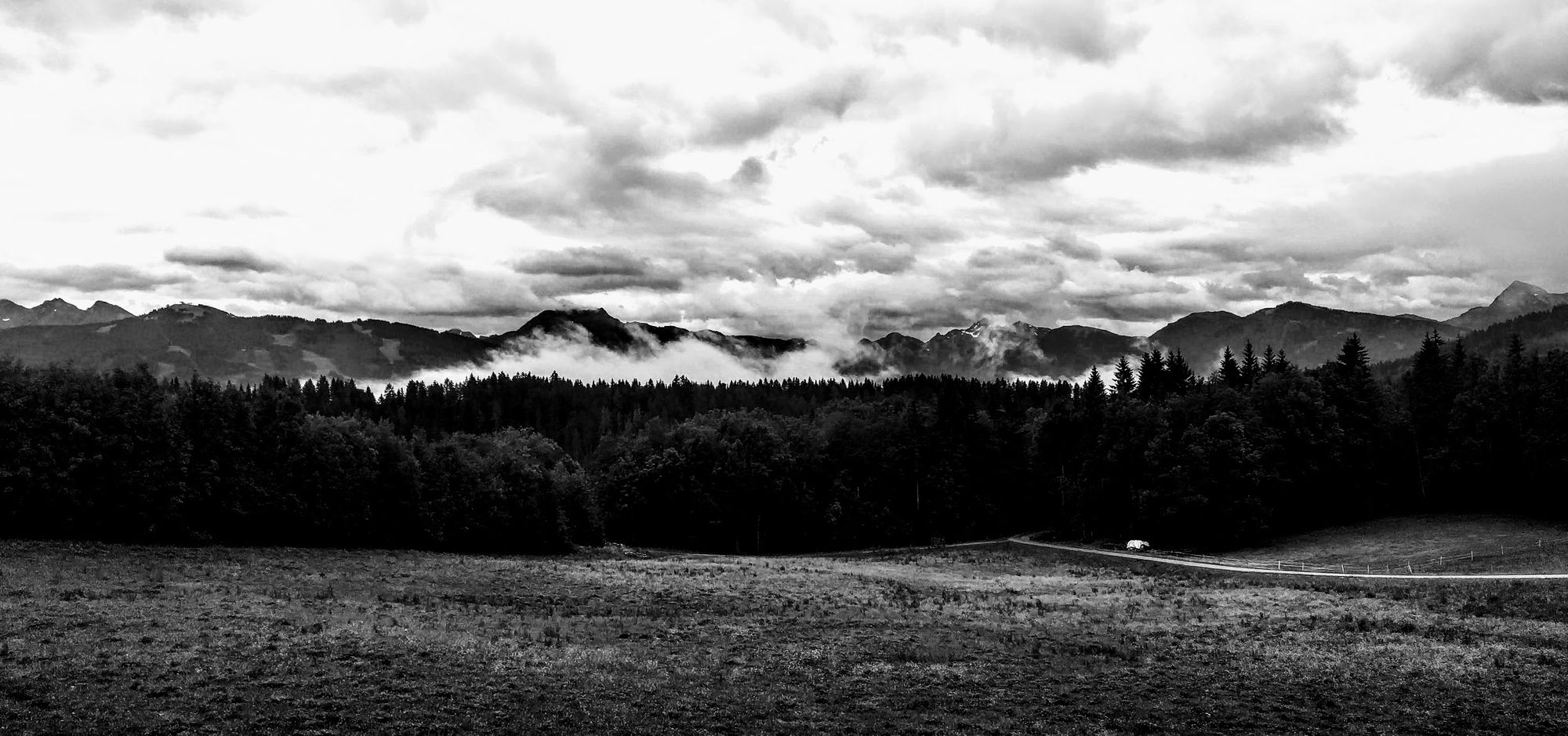
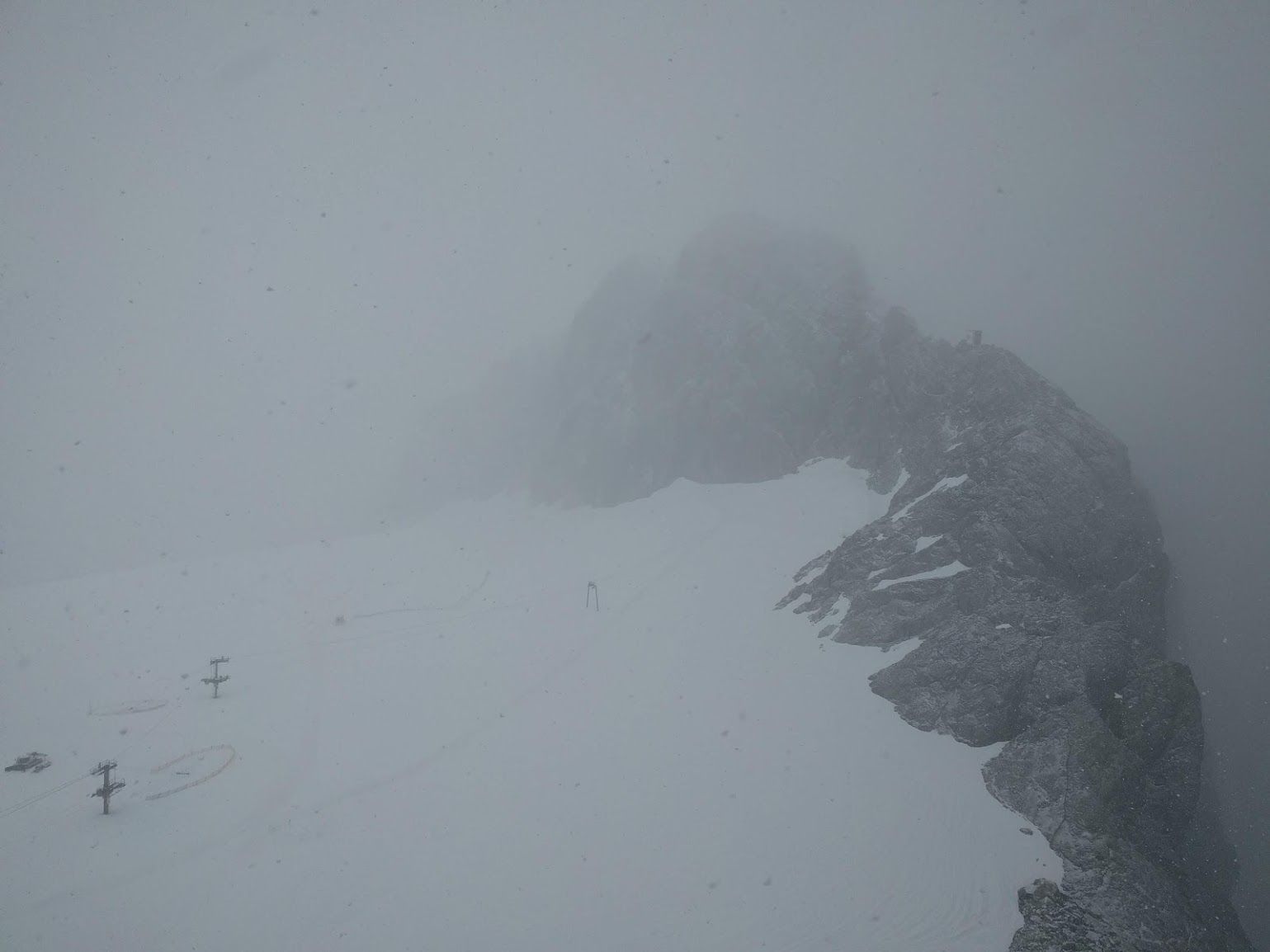
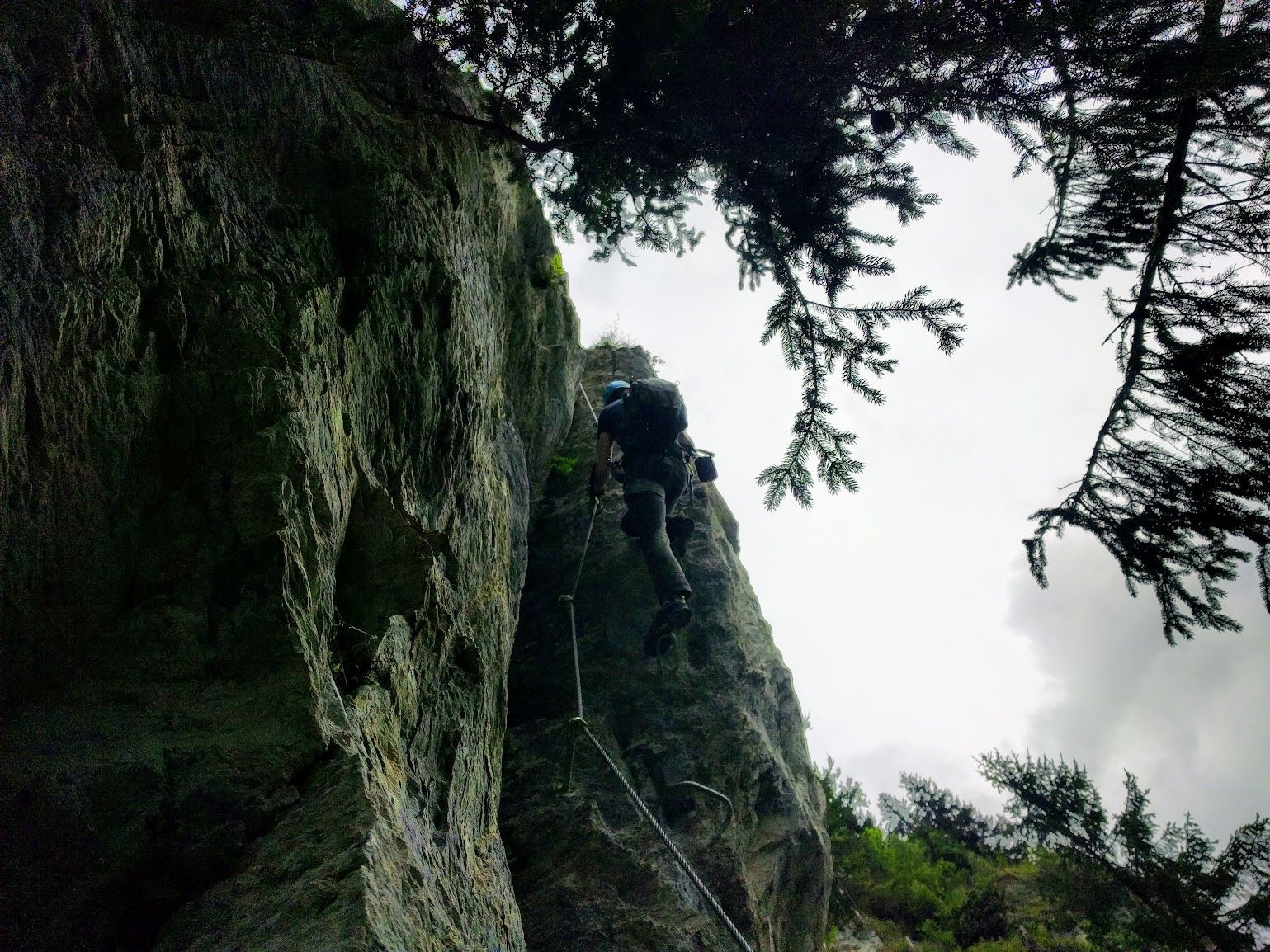
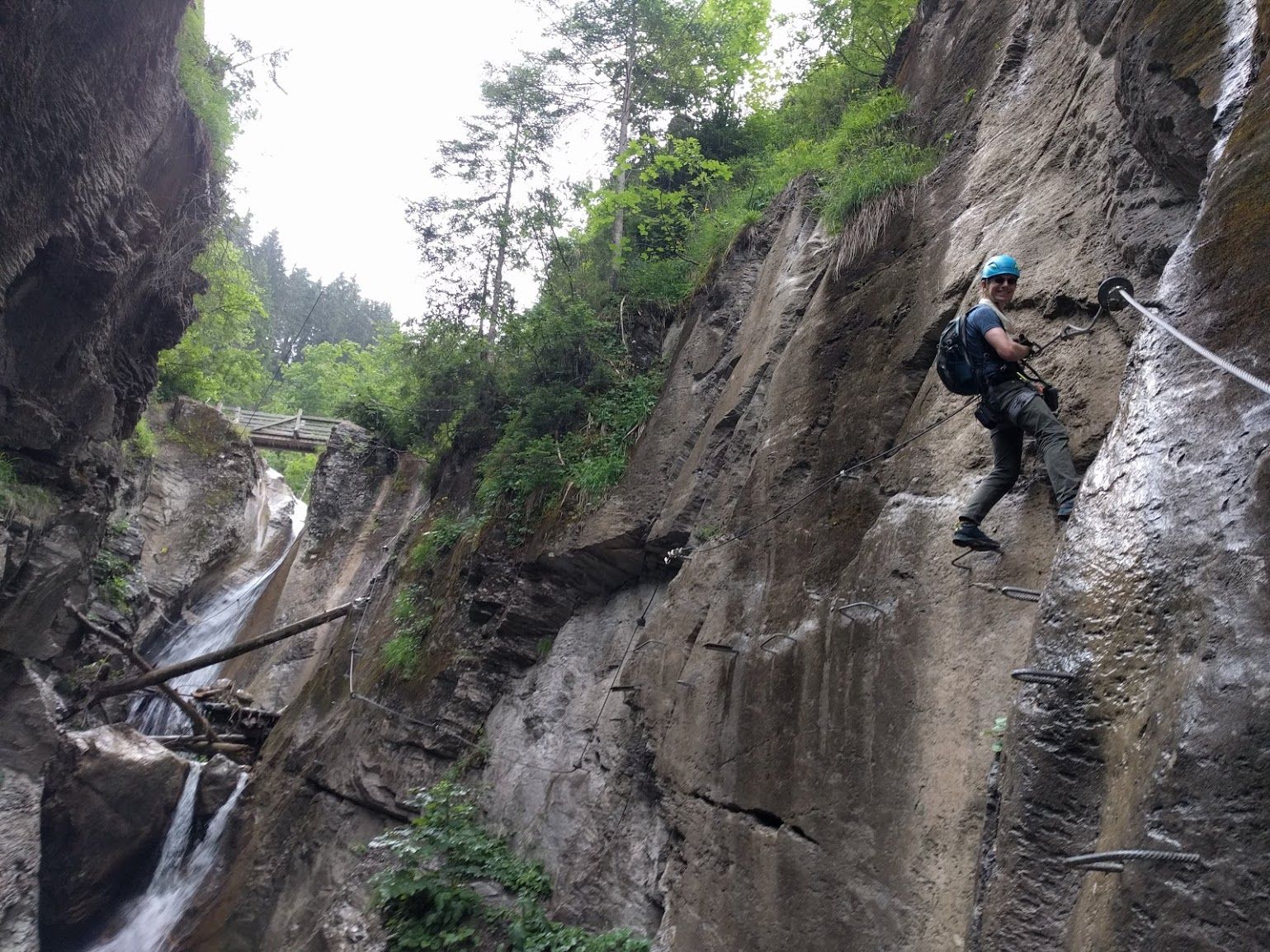

If the weather is bad, hiking sucks. Climbing even more so. Passing over a summit ridge at temperatures below zero in a sleet storm on a glacier – suicidal. There went our last big project for the trip. – When the clouds the next morning were drooping so close over our heads we could actually touch them, we took a gondola up to the Dachstein glacier station to at least have a look at the place. The conditions being as they were, visibility at 20-60m, we couldn’t even take any impressive pictures. Small solace in this, the mentioned „summer card“ had us take the ride for free. Also, the experience of feeling sleet on my face in mid-July did instill me with some due respect for the force of nature reigning here.
What’s good about weather in the mountains, though, is the fact that it might be totally different the next valley over! So once back from the glacier, Bengt and I took to the road, no particular goal in mind but to find a place that wasn’t frozen solid. Checking with the usual sites online for suitable places to hike or climb in the vicinity of the Dachstein, we ended up in a pretty little place called Kleinarl, just some 50km away. There, a forested cliffside shoots up from the level valley floor which turns the ascent a literal stroll in the park which offered two real Via Ferrate we then set out to climb. The first one, called „Peilsteinpalfen Klettersteig“, is a short but intense 30-40 minute route that traverses the steep cliff face with slippery footholds leading into a chimney finish that surprisingly packs quite the punch. Having pulled consistently on the fixed ropes of the Silberkar routes just the day before, we very much felt how shredded our forearms still were and accordingly succeeded just barely to top this one. It might not be that hard a climb, really, but four days in, almost failing here was just too close for comfort.
So we did the reasonable thing and went downhill, passed a zipline park in the woods, used a fixed rope protected family route to get down and found the entrance to the second Via Ferrata in this sector, the „Kesselfallsteig“. Leading through a small canyon with a rainfall swollen creek at the bottom, this scenic pleasure-walk Via Ferrata did itch our sense of adventure, again, and had us ignore our sore muscles one last time for an easy and plain enjoyable 20 Minute climb. The dumbstruck faces of the people who saw us jumping up onto the bridge crossing the chasm was a nice touch, too.
The final evening we spent at a nice restaurant in Schladming, again, with some of the best food of our trip, reminiscing our adventure, discussing Bengt’s already mentioned ensuing stay at Berchtesgaden and Watzmann Traverse and pitching ideas for other joint endeavors. – You might just read of those here some time, too, won’t you? See you then.
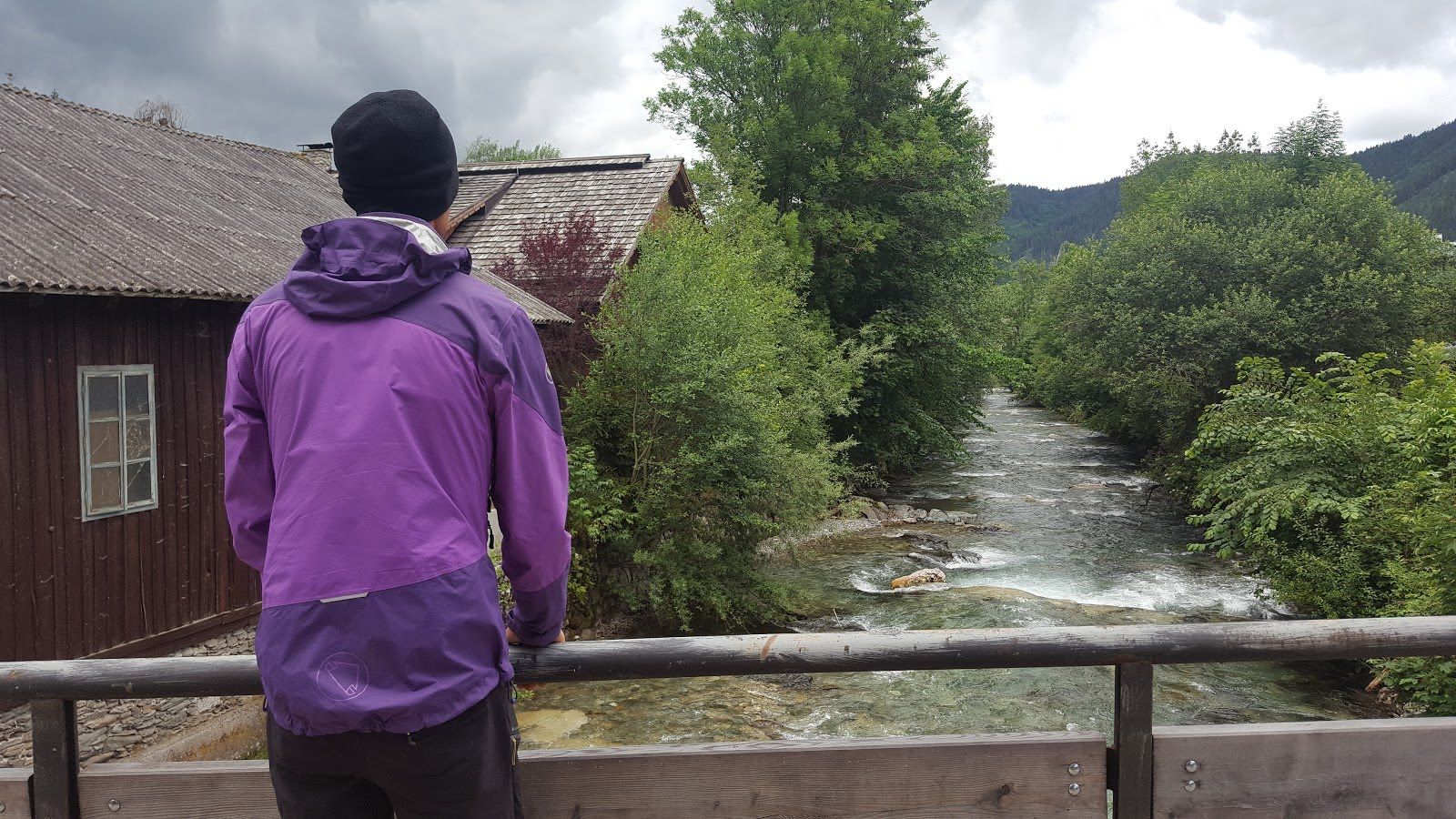
Adventurers: Bengt and Jost
